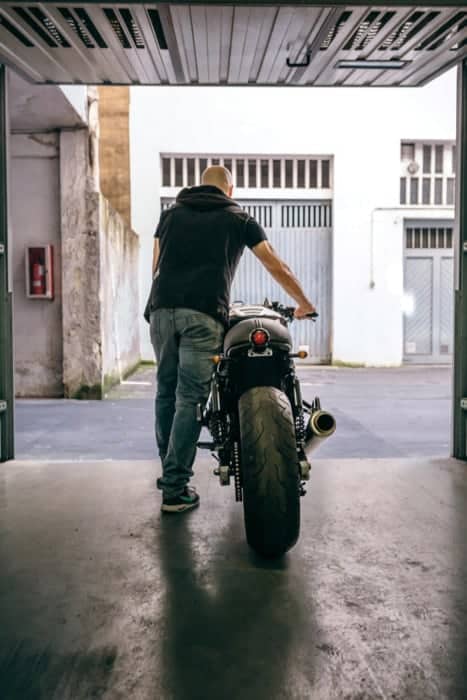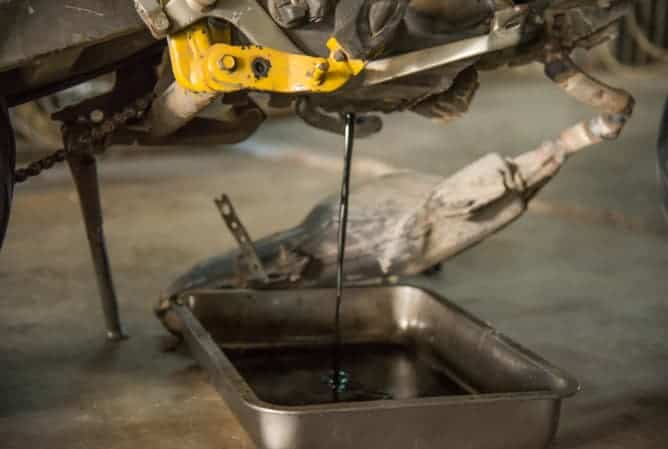
There are several things a motorcycle owner must do before storing their motorcycle for the winter. If it’s done improperly, that could mean some expensive damages done to the motorcycle.
But most of the time it takes a lot more than just simply starting the bike after taking it out of storage. There are several things that need to be inspected and checked before taking the motorcycle out for a ride. This article can explain exactly what you need to look for and how to start a motorcycle after storing it for the winter.
Why You Should Inspect Your Motorcycle Before Starting It
If the proper steps were taken to prepare the motorcycle for dormancy before it was stored, starting it up should be a breeze. But not everyone takes the right steps in doing so and even the best of us forget a certain step before storing it.
Keeping a motorcycle stored for several months (or even years) is completely possible, but that doesn’t mean it’s not hard on the motorcycle. Motorcycles were made to run and be used, so checking certain points of the motorcycle after winter storage will ensure damage isn’t done. Doing this will also cover any mistakes or points you forgot to take care of before storing it.
1. Tires
Tires are often one of the most neglected parts of a motorcycle. This is unfortunate because they’re basically what’s keeping the rider and the road separated. Surprisingly, there’s a lot that can happen to a tire during storage.
Before starting your motorcycle, inspect the condition of the tires and ensure they’re still in good working order. The lack of usage can actually wear out tires a lot faster than using them. Inspect for any cracks, bulges, or flat spots if the tires were not elevated. If you find any of these, you’ll likely need to get them replaced.
It’s also important to check the tire pressure. Over time, a motorcycle will lose air pressure even when it’s not being used. This is due to two things: change is temperature and osmosis. A motorcycle tire loses about 1 PSI for every 10° drop in outside temperatures. This may seem insignificant, but if you think about the difference in temperature between fall and winter (usually about 50°), that can be a matter of 5 or so pounds of air.
Osmosis (also known as permeation) is a process where air is able to escape through the elements of the rubber in the tire. Over the course of several months, osmosis has likely taken place and your motorcycle will need more air added to them.
2. Carburetor
If you have a carburetor on your motorcycle, you’ll likely be spending most of your recovery time on this particular part. Carburetors are great mechanisms in the functionality of a motorcycle, but they’re also the most finicky.
If you took the proper steps to prepare your motorcycle before storage, you likely added some fuel stabilizer or you simply emptied your fuel system altogether. While both will greatly help with the health of the carburetor, you’ll still need to check it especially if you regularly use gas with ethanol in it.
If you’re having trouble starting the motorcycle, the culprit is probably the carburetor. Residual fuel inside the carburetor can gunk up over time, even in a few months, without usage. Because the fuel passes through small jets in the carburetor, the carburetor is susceptible to getting clogged from the gunked up fuel and won’t be able to produced the right fuel delivery to the engine.
This doesn’t necessarily mean you’ll need to do a whole carburetor rebuild. You can first try removing the bowls on the bottom and spraying some carb cleaner up inside. For more information on how to do that, see my other article by clicking here.
3. Fuel
Believe it or not, gas does have a shelf life. People wonder why that is possible since it survived underground for thousands of years. That’s because that oil found in the ground is unrefined. Once gas has become refined, it doesn’t last near as long and needs to be used.
Before storing a motorcycle for the winter, a fuel stabilizer should be added or the fuel should be completely emptied altogether if your situation calls for it. Unstabilized gas will start to go bad after about 30 days. Stabilized gas can last 6-12 months.
When starting your motorcycle after storing it for the winter, check the condition of the gas. If you had it stored for longer than 12 months, it’s possible it has gone bad and you’ll need to replace it altogether.
You can tell if gas has gone bad first from the smell; it will smell off and not much like the smell of gas you’re used to. You can also tell if it’s bad by the look of it. Bad gas will start to get a varnishy texture may have a green tint to it.
You may be able to start your motorcycle with expired or bad gas, but your motorcycle won’t run well and it will likely clog up the carburetor at some point. Bad gas calls for emptying the tank completely and refilling it with fresh gas. You can empty the gas can by removing the fuel lines from the carburetor and placing the petcock on reserve (if your motorcycle has it) and letting the gas run out into a container. For more ways on how to empty a gas tank, see my other article by clicking here.
4. Oil

When starting up your motorcycle after storage, you’ll need to change the oil whether or not you changed it before you stored it. This doesn’t necessarily need to be done before the motorcycle is started and ridden, but it does need to be done before riding it for too long.
Hopefully you changed the oil before storing it for the winter. It may seem a bit pointless changing the oil before storing it only to change the oil again when you bring it out in the spring. But there’s a lot to changing the oil that you can’t see that happens within the engine.
Oil still has the tendency to break down inside a motorcycle even if it’s not being used. This is especially true if you didn’t change the oil before storage; the oil will actually break down much more quickly in this case since it’s usage has already partially changed it’s chemical compounds.
Age is the biggest reason you need to change the oil. You don’t want to be running on old oil that’s going through the engine providing less than optimal lubrication. The engine has already been through enough just sitting there, give it it’s best chance by feeding it with some fresh oil that will ensure it runs well.
5. Hoses/Wires
Like the tires, hoses on a motorcycle have a tendency to break down without usage. You can think of it like muscles on a human body; without using them, they get weak and don’t work as well when you try to engage them. Again, motorcycles were made to be used, so dormancy can be hard on those hoses.
When starting your motorcycle after winter storage, inspect the hoses and make sure there aren’t any cracks or detachments. Replace them as needed preferably before starting the motorcycle since it’ll likely run rough or won’t run at all without those replacements.
Also inspect the wires and make sure small varmint haven’t chewed away at any of them. Mice especially take a liking to motorcycles during the winter time since there are plenty of nooks and crannies to nest in. They also like to chew things like wires because it helps file their growing teeth.
6. Battery
Dealing with the battery is probably one of the most frustrating parts about taking a motorcycle out of storage. It’s common to have a dead battery after doing this, even if you tried to keep it charged during it’s dormant months.
Your motorcycle isn’t going to start if the battery is dead or doesn’t have enough voltage. Starting a motorcycle up after it has been sitting for a while will take more battery power than normal since the engine oil may have lost some of it’s viscosity which means the pistons have to work a little harder to move up and down.
Cold temperatures can also be quite harsh on a motorcycle battery. It’s completely possible for a motorcycle battery to freeze; a lot of that depends on the age of the battery and how much voltage is left. But when left dormant at less than a 100% charge, the battery is likely to drain much more quickly.
Test the voltage of the battery using a multimeter. In order for it to start a motorcycle, a battery must have 12 volts. Anything less than that will likely result in an unsuccessful startup. If you always have to charge the battery before every startup after that, you’ll need a new one.
If a new battery doesn’t solve the problem, the issue might be with the stator. See my other article here to learn about how to keep a motorcycle battery charged during the winter.
7. Leaks
Don’t forget to inspect the ground the motorcycle has been parked on while you’re starting up after storage. Any leaks will likely indicate itself by forming a small puddle.
The cause of leaks can range anywhere from a mild issue to an underlying problem that should be promptly fixed. If you notice any puddles on the ground, try to identify what type of fluid it is and exactly where the leak is coming from.
Sometimes when a motorcycle sits in storage for a while, the gaskets in the engine get brittle. Gaskets in an engine last much longer when an engine is regularly used because they’re being exercised. Brittle and less effective gaskets means you could get an oil leak. If the puddle on the ground is oil, be sure to check the gasket surfaces.
If the leak isn’t from oil, it’s possible for it to be coolant if you have a water cooled engine. You can tell it’s coolant by the sweet smell it’ll have or the neon green color (for most motorcycles). Though it’s much less likely, it’s possible you could be leaking brake fluid if you find a puddle on the ground. This is a leak that you should fix before starting up your motorcycle and taking it for a ride; otherwise you could have issues with the braking system.
8. Wash It
Once you take your motorcycle out of winter storage, it’s important that you give it a good wash to rinse off all the dust and dirt that has accumulated while it was sitting. Dust and dirt have a tendency to absorb any moisture which can lead to rust; this is especially true if you didn’t wash your motorcycle before storing it.
Be careful to not use a high pressure washer to wash your motorcycle. That can ruin delicate parts that are exposed. If possible, the best type of motorcycle wash is one that’s done by hand. Also make sure that you don’t use dish soap to clean it. Dish soap can be extremely harsh on the clear coat of the tank.
Some Things To Check For When You Take It For The First Ride
It’s definitely a good sign if you’re able to start your motorcycle right up after storing it. But you’re not completely in the clear yet and there are a few things you should watch out for during that first ride.
First, notice how the motorcycle handles and if it’s performing poorly compared to how it was before you stored it. If you notice there’s any kind of sputter, you may have some sort of carburetor clog or a vacuum leak. This can be caused by gunked up fuel or brittle or detached hoses.
If you notice the ride is bumpy, you’re getting pulled to one side, or there’s a vibration, you may have some issues with the tires. Sometimes upon a visual inspection tires can look just fine. Problems with tires may not manifest themselves until you’re actually out for a ride. These issues can be caused by too flat or too inflated tires, unbalanced tires, uneven or bald tread, or leaks somewhere throughout the tire.
It’s also somewhat common to have a motorcycle backfire once it’s taken out of winter storage. This can be caused by either a loose air box or, more likely, issues with the carburetor because it’s not giving the right fuel delivery.

